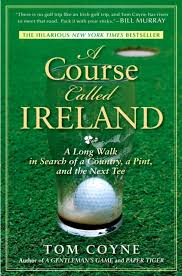
A Course Called Ireland: A Long Walk in Search of a Country, a Pint, and the Next Tee
Share
Kicking off the Low Chaser Book Club I decided to go with a book I loved, "A Course Called Ireland" by Tom Coyne. Tom is a veteran golf writer, and currently plies his trade as the editor at "The Golfers Journal" (of which I am a subscriber), as well as the owner at Sullivan County Golf Club. It's fair to say he is a lover of both the game, and of Ireland. (He also get's bonus points for being an honorary member at my home club of Ballybunion).
The book is more than just a golf travelogue—it's a 1,100-mile walking odyssey that marries the ancient game with Irish culture, history, and character. Published in 2009, this ambitious narrative follows Coyne as he attempts to walk the entire perimeter of Ireland while playing every seaside golf course along the way. As someone that spent a week cycling (and drinking) from Mizen to Malin (the southerly most point, to the most northerly point), the thought of someone doing the journey by foot in particular appeals to me.
The Journey Behind the Journey
Coyne's adventure begins with a seemingly impossible premise: walk the coastline of Ireland with nothing but a backpack full of golf gear and a romantic notion of discovering his ancestral homeland. What unfolds is a deeply personal narrative that weaves together the author's physical challenges, cultural discoveries, and the unique character of Irish links golf.
More Than Just Golf
While golf serves as the backbone of the narrative, Coyne's keen eye and witty prose capture the essence of Ireland itself. From chance encounters in local pubs to conversations with farmers whose land has hosted golf for centuries, the book paints a vivid portrait of modern Ireland while honoring its traditions. His descriptions of lesser-known courses like Carne and Narin & Portnoo sit comfortably alongside accounts of famous links like Ballybunion and Royal County Down.

Where the Book Excels
The strength of "A Course Called Ireland" lies in Coyne's ability to balance multiple narratives. He seamlessly transitions between detailed golf course descriptions, personal reflection, historical context, and humorous encounters with locals. His writing style is accessible yet sophisticated, making the book appealing to both golf enthusiasts and general readers interested in Irish culture.
The physical challenge of walking the entire journey adds a compelling layer of authenticity to the narrative. Coyne doesn't shy away from describing the blisters, rain-soaked days, and moments of doubt that accompanied his adventure. These hardships make his golf triumphs and cultural discoveries all the more meaningful.
I also use it as a reference for new courses to play when I'm in different parts of the country.
Minor Shortcomings
At times, the day-to-day accounts of walking between courses can become repetitive, and some readers might find certain sections overly detailed about golf course architecture. However, these minor issues don't detract significantly from the overall narrative.
Final Verdict
"A Course Called Ireland" succeeds brilliantly as both a golf book and a travel memoir. Coyne's journey offers insights into Ireland's golfing heritage while exploring themes of identity, perseverance, and the unique connection between a land and its people.
In the growing genre of golf travel literature, "A Course Called Ireland" stands out for its ambition, authenticity, and heart. Coyne's walk around Ireland's edges leads him—and his readers—to the heart of what makes Irish golf, and Ireland itself, so special.